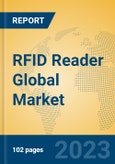Market Size and Growth Forecast
The global RFID Reader market is estimated to reach a value of approximately USD 1.4 to 1.8 billion in 2025. It is projected to grow at a compound annual growth rate (CAGR) of 3.5% to 4.5% from 2025 to 2030, potentially achieving a market size of USD 1.7 to 2.2 billion by the end of the decade. This growth trajectory reflects steady demand driven by digital transformation initiatives, though moderated by regional variations in adoption rates and infrastructure readiness.Regional Analysis
- North America: Accounting for 35-40% of the market share, North America exhibits a growth rate of 3-4%. The United States dominates due to its advanced retail and logistics sectors, with trends focusing on inventory management and anti-counterfeiting measures. Canada complements this with steady adoption in transportation.
- Europe: Holding 25-30% of the market, Europe grows at 3-3.5%. Germany and the UK lead with strong manufacturing and healthcare applications, emphasizing regulatory compliance and automation. Market trends highlight sustainability-driven tracking solutions.
- Asia Pacific: Representing 25-30% of the market share, this region sees the highest growth at 5-6%. China and Japan are key drivers, with China focusing on manufacturing scale and Japan on precision logistics. India’s retail boom adds momentum, with trends leaning toward smart supply chains.
- Rest of the World: With a 10-15% share, this region grows at 4-5%. Latin America, led by Brazil, and the Middle East, with the UAE, see uptake in logistics and healthcare, driven by infrastructure investments and trade hubs. Trends emphasize cost-effective deployment.
Product Type Analysis
The RFID Reader market is segmented by product type, with growth trends reflecting application needs:
- Handheld RFID Reader: Expected to grow at 4-5%, these devices are favored for their portability and flexibility in retail and logistics. Trends focus on ergonomic design and battery life enhancements.
- Fixed RFID Reader: Projected to grow at 3-4%, these are deployed in manufacturing and transportation for continuous monitoring. Trends emphasize integration with IoT platforms and higher read ranges.
Key Market Players
Prominent companies shaping the RFID Reader market include:
- Zebra Technologies: A leader in rugged mobility solutions, offering RFID readers for industrial and retail use.
- Datalogic: Specializes in data capture technologies, providing versatile RFID solutions for logistics and manufacturing.
- Honeywell: Delivers robust RFID readers focused on supply chain and safety applications.
- Panasonic: Offers durable RFID devices tailored for industrial automation and healthcare.
- Impinj: Focuses on advanced RFID technology for real-time inventory and asset tracking.
Porter's Five Forces Analysis
- Threat of New Entrants: Medium; high technical expertise and investment needs deter newcomers, though niche markets in emerging regions offer entry points.
- Threat of Substitutes: Medium; barcodes and QR codes compete on cost, but RFID’s speed and automation maintain its advantage in high-volume settings.
- Bargaining Power of Buyers: High; large retailers and manufacturers leverage volume purchases to negotiate prices, pushing for cost-effective solutions.
- Bargaining Power of Suppliers: Medium; reliance on specialized components like antennas gives suppliers some leverage, though diversified sourcing mitigates this.
- Competitive Rivalry: High; key players vie for dominance through technological differentiation and pricing, intensifying market competition.
Market Opportunities and Challenges
Opportunities:
- Rising e-commerce and omnichannel retail demand real-time inventory tracking, boosting RFID adoption globally.
- Smart manufacturing initiatives, driven by Industry 4.0, enhance RFID use for automation and traceability.
- Expansion into emerging markets like India and Brazil, where logistics and healthcare modernization fuel growth.
Challenges:
- High upfront costs and integration complexities limit adoption among SMEs, necessitating scalable solutions.
- Regulatory variations across regions complicate standardization, impacting deployment timelines.
- Supply chain disruptions from tariff disputes and component shortages require agile sourcing strategies.
This product will be delivered within 1-3 business days.
Table of Contents
Companies Mentioned
- Zebra Technologies
- Datalogic
- Honeywell
- Panasonic
- Urovo
- Shenzhen Chainway Information Technology
- Impinj
- Invengo Information Technology
- JADAK
- Shenzhen RodinBell Technology








